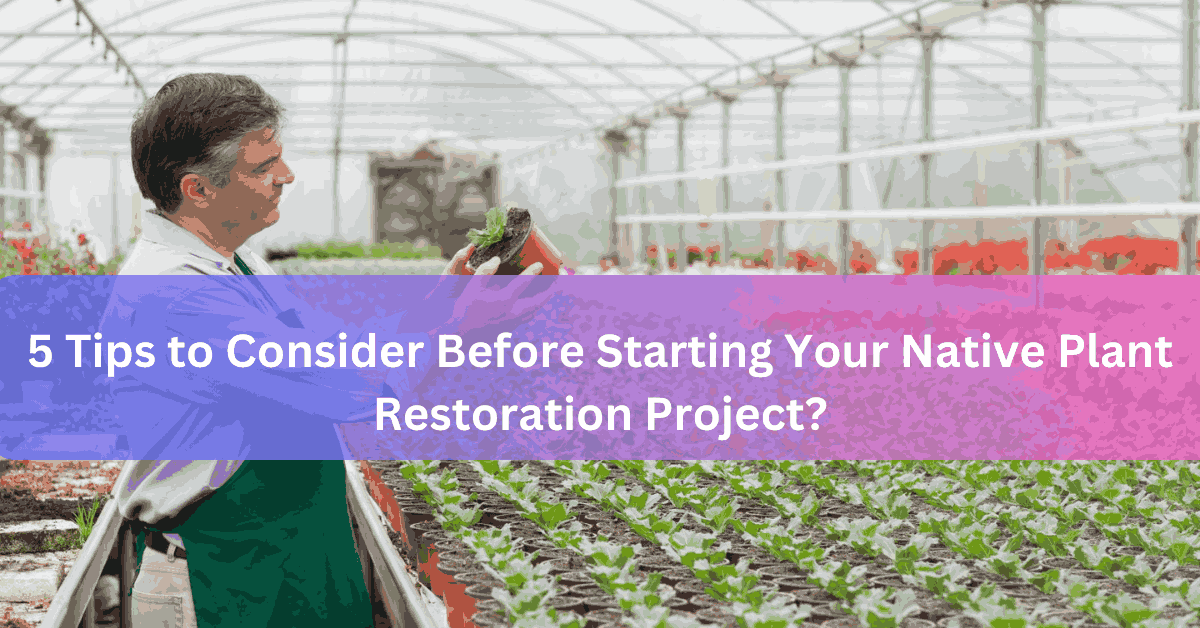5 Tips to Consider Before Starting Your Native Plant Restoration Project
If you’ve decided to plant natives, you likely know and appreciate their many benefits. Knowing your site’s characteristics and long-term goals will help ensure your project’s success.
Create attractive, working natural habitats and connect with nature with these tips from a Native plant nursery.
1. Research the Natives That Thrive in Your Area
Native plants are adaptable. However, having evolved in natural communities, they prefer certain growing conditions. Understanding your region’s natural communities can help you create successful landscapes.
Take your cue from plants that grow in natural communities. They work in landscapes with similar features and provide habitat for wildlife. For example,
- Prairie/grasslands. Low-height grasses that offer long vistas.
How to use. Create shapes by reducing mowing and incorporating plant drifts to increase diversity. It can be dry, moist, or wet.
- Savanna. A mix of grass, scattered trees, and shrubs.
How to use. This is an ideal inspiration for suburban landscapes. Open areas blended with landscape beds for color and interest. Trees and shrubs offer shade, screening, and extra texture.
- Forests: A patchwork of plant communities with varying shade tolerance and different shade densities.
How to use. Shady sites can draw on the cool drama of a wooded parcel to create lush oases. Vary shade densities by removing low limbs or thinning trees. Layer shade-tolerant shrubs under canopy trees and over woodland plants.
- Glade: Open, sunny area with shallow, rocky soils at the edge of woodlands.
How to use. Choose drought-tolerant perennials and low- to medium-height grasses for this easy-care site.
- Wetlands: Permanently or seasonally flooded or saturated sites creating oxygen-deprived soils.
How to use. Wetlands are home to a variety of trees, grasses, sedges, rushes, and perennials. Naturally wet areas can form the nucleus of a pond garden or rain garden. Wetland woody plants also perform well on compacted, anaerobic urban soils.
Learn more about natural communities and how they compare to your specific site. Consider which plants grow best in your locale and on your specific site. Or, if your goal is improving habitat, how you can use native plants to adapt your site and reach that goal.
2. Get to Know Your Soil
Soil qualities vary throughout different regions of the country. Knowing your soil characteristics, e.g., sandy, clay, loam, helps you select the best natives for your site.
Review your county’s soil atlas for a general idea of your landscape’s soil.
3. Find a Native Plant Nursery That Knows Natives
Many nurseries sell natives. But with Forrest Keeling’s decades of experience, you get more than plants. Their RPM technology delivers native plants that perform better and faster. The patented 12-step RPM technology is unique.
- Seed Provenance
Provenance is like a plant’s internal clock that tells the plant when to break dormancy. It also helps ensure consistent flowering and fruiting at your planting sites. Forrest Keeling collects quality seed across the country and location-codes it through production. RPM-produced, coded seedlings deliver the best performance in their final planting sites.
- Faster Results
The all-natural RPM-production method yields twice the results in half the time. Scientific studies show our RPM-produced plants grow, flower, and fruit two times faster.
- Superior Survivability
Greater root mass improves transplant success. Additionally, RPM root mass leads to a 95% survivability rate.
- Lifetime Vigor
Using a proprietary soil media, RPM plants have greater access to nutrients. In fact, our soil media is as alive as our plants! Rich with mycorrhizae, it’s proven to improve the soil at each plant’s installation.
4. Manage Your Timeline Expectations
Native plants nursery can take several years to establish root systems, flowers, and bear seed or fruit. You can expedite your results by choosing RPM-produced plant material. RPM-produced plants are proven to grow, flower, and fruit two times faster.
While natives may be characterized by lower maintenance, they do require care. This includes adequate water during their first year of establishment. You’ll need a regular plan to help control weeds and occasional wildlife interference. Early on, mulch can help prevent weeds and encourage growth in seedlings.
If you’re considering a native plant project, explore the benefits of the patented RPM system.


